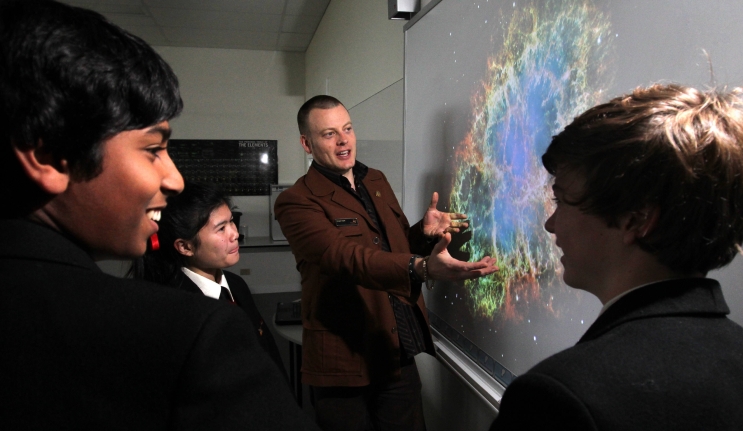
RESEARCH NEWS
Big History gets even bigger
Big History’s potential for it to be a major turning point in modern education will be the focus when educators, scholars and policy makers as well as multimedia and technology innovators come together at the inaugural Big History and the Future of Education conference.
Big History is the brainchild of Macquarie’s Professor David Christian, who developed the concept in 1989 as a way to tell the story of the world from the Big Bang to the present, while showing how different disciplines from the sciences and humanities are connected.
Originally developed for university students, a version of the course targeted at high school students is now being rolled out across Australia. A primary school program is also under development.
Andrew McKenna, Head of Partnerships and Development for the Faculty of Arts, says that one reason for the concept’s popularity both in Australia and internationally is that recently knowledge has become so specialised that people tend to focus only on a single discipline without viewing the information in its broader context.
“It’s hard for students to understand how physics, chemistry, history, biology and geography are relevant to them, or how they fit into the big picture. This detail-led approach is one reason students disengage from learning,” he says.
“Big History excites people because it connects knowledge, gives them the back story and a vocabulary to understand the world they live in. Once they are engaged, they are then more interested in learning the details.”
Special Projects Manager for the Big History Institute Tracy Sullivan is leading the schools rollout, and says there are 36 schools currently trialling Big History across Australia. A further 100 schools have registered their intent to teach the course next year.
“The response has been absolutely overwhelming,” she says. “Of the schools that have trialled the course we have had a full retention rate, with students reporting that it has given them an exciting way to connect the knowledge they have learned across different subject areas.
“They are inspired because they see the relevance of their studies to their everyday lives.”
She says that parents love it so much that they are bringing the idea to their kids’ schools; teachers, principals and education departments are also very enthusiastic about it and are approaching the Big History Institute as well.
“Big History can be as complicated or as simple as you want to make it, with a narrative that is just as interesting to students in year one as it is to year nine or university students,” Ms Sullivan says.
Andrew McKenna says that private sector organisations and high profile individuals such as Bill Gates have also thrown their support behind the program
“Both governments and businesses recognise the importance of breaking down discipline barriers and developing students with an interest in both science and the humanities, rather than simply labelling someone as a ‘maths person’ or an ‘English person’,” he explains.
“Organisations see Big History as an on-ramp to learning lots of disciplines that will pay big dividends throughout their education and once these students join the workforce,” McKenna adds. “It also plays a key role in getting them to think beyond the present and how they might contribute to the future.”
More information about the conference, which will be held on 5-6 December, can be found on the Big History Institute website. If you missed out on studying Big History at university, Professor Christian and his team have made a version of the course available to the public – get started at the Big History Project site.
Teachers or educators interested in teaching big history in their schools can contact Tracy Sullivan at tracy.sullivan@mq.edu.au
What did you like most about studying Big History?
My first lecture/tutorial at Macquarie was Big History, and I loved the scope of the course. From the beautiful slides of the known Universe, the Big Bang, the theories on the concept of Time, the Evolution of Species, the Hunter/Gatherers and Prof Christian’s knowledge of and enthusiasm for his subject, I was hooked.
I can think of no better subject than this for school students of any age (I love that it can be tapered to their understanding), but it taught me some things when I enrolled at Macquarie in 1996, under the Silver Jubilee Mature Age Entry system, at the age of 55. By now (I graduated in 2000) I would assume that more has been added to the course, taking it up to (and maybe in to) the New Millenium.
More power to Macquarie, and to Big History.
Regards,
Wendy Maxwell
I agree with Wendy Maxwell that the scope of Big History is one of its most valuable characteristics. It is most important that students, whose focus in history may very well have been almost exclusively on Europe, should appreciate the complexity and sheer technological expertise of early Asian societies as well.
I was amazed to learn, for example, that in ancient China not only was moveable type in use, with the distribution of news letters to to the far-flung public servants, but that modular building construction and mass production were common. At a time when the European powers had just discovered America, Chinese junks were trading regularly as far west as the Red Sea.
A course like this will help students to understand and to integrate with our Asian neighbours, as well as give them a broad outline of some of the more important strands of scientific research.
How about introducing Big History into the first-year science curriculum at Macquarie, or has that happened since my time?
Regards,
Daphne Martin